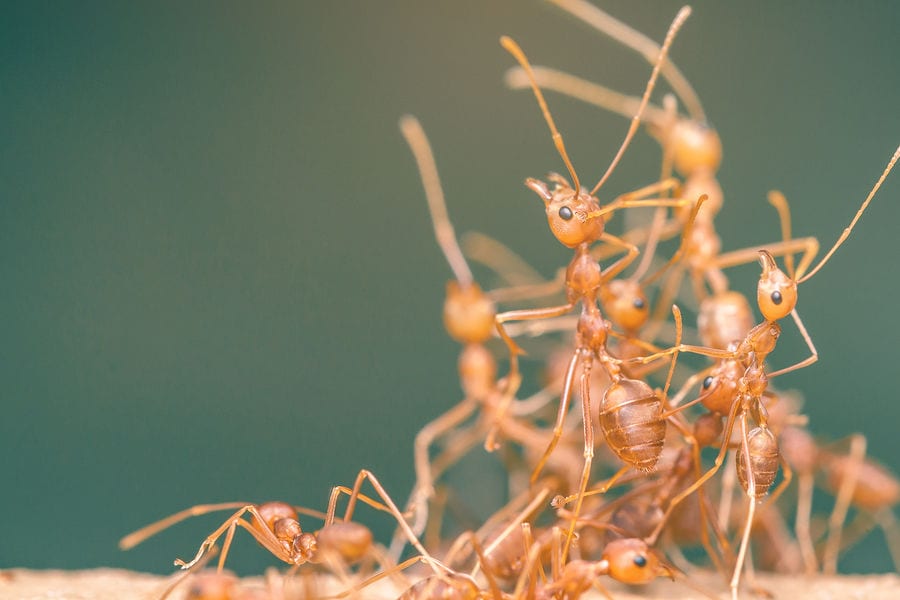ANT CONTROL
Discover Your Options To Fight Them
Ant Control in Central and Southern New Hampshire
Most commonly, we identify with ants when we see them trailing to and from food sources in our home. Outside of your home, you may see mounds of dirt and sand in your yard. Ants such as carpenter ants may be seen crawling in and out of vents and other structures.
Depending on the type of ant, they can also be nesting in walls and other hard-to-see-spaces. Additionally, you may be able to hear them rustling around within the walls. Do you see piles of wood shavings around your home? Like contractors who excavate before building, so do ants, they excavate when they build their nests.
Are you experiencing any of these issues? Do you think you need ant control services? If so, it’s time to reach out to a reliable pest ant control company, like the team here at Garfield Pest Control.
In order to battle the infestation, since different ant species have different habits, identifying the species that is causing the problem is vital. Our team has the training, knowledge, and experience to provide expert ant removal services.
To learn a few facts about ants, keep reading, then get in touch with us to start your ant removal services.
Facts About Ants
Habitat
Carpenter ants are primarily wood nesting ants. Their nests can be found in various locations, but they are most often found inside trees, stumps or moist wood both inside and outside buildings.
Carpenter ants are hardy durable insects that have several special attributes that help them survive; They can survive harsh winters at temperatures of 7 degrees below zero or more because they have a natural “anti-freeze” in their bodies called glycerol, which prevents them from freezing.
They can also withstand immersion underwater for up to 70 hours without drowning. Also, they can go without food for six months during their dormant periods.
Mating and Lifespan
Queen carpenter ants can live 10 to 25 years under ideal conditions.
Carpenter ants are “social insects” that interact as a community or colony, and there is a “division of labor” between adult forms. These ants have three sizes of workers; Major, Intermediate and Minors. All these workers are sterile females.
Queen ants and the smaller male ants are born with wings and are known as reproductive ants. Their wings are discarded after mating, and the males die soon after.
Diet
Approximately 10% to 20% of carpenter ants forage for food and water, depending upon the time of the season.
Most of the ant population remains in the nest where they work at enlarging the nest by excavating wood or insulation.
Carpenter ants do not eat the wood; they simply cut and remove wood and other debris.

Ants Nesting Areas
Carpenter Ants usually have a main nest either outside or inside while they frequently have one or more satellite colonies.
They nest in many places such as:
- Hollow wood or metal doors
- Subfloors
- Under bathtubs and toilets
- In sills and headers of the foundation
- In exterior and interior walls
- Between insulation in floors and ceilings
- In attics
- Inside garden hoses
- In bark mulch and in between the plastic covering underneath
- Also in many other unpredictable places
Treatment
It is most important to locate and treat internal and external nests and travel routes. This cannot be achieved by just spraying, as this will only kill foragers. Proper void treatments take longer to perform but are much more effective than just spraying alone.
Due to nesting behavior, it is highly recommended to perform follow-up treatments for a period of time, such as “Quarterly Services’. This keeps ants in check because of fresh active residual materials. There is no odor, and these materials (when used as directed by the label) are low risk around plants, animals, and people. Quarterly Services are economical and cover most other insects as well.
Bait Shy
Carpenter ants are bait shy when it comes to over the counter preparations such as ant cups. They can detect most poisons in parts per million. They will sometimes sample these cups and then stop feeding.
Even special prescription baits are sometimes turned down. This is partly because ants have specific nutrition requirements that vary month to month throughout the season. I.E., Prescription baits seem to work best early in the spring and not so well towards the end of summer.

